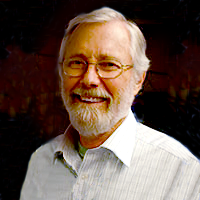Article begins
Both the discipline of anthropology and the Agta Indigenous people of Casiguran, Philippines, lost a scholar, a friend, and an advocate in the passing of Dr. Thomas N. Headland on February 1, 2024. His wife and colleague Janet preceded him by one year. Tom served in the US Army 508 Airborne Regimental Combat Team from 1954 to 1956 and continued a passion for skydiving during his early years in the Philippines. He graduated from Bethel University in 1960 and was awarded an MA and PhD in anthropology from the University of Hawai’i in 1981 and 1986, respectively. He served as an SIL International anthropology consultant from 1984 until his death.
Together, Tom and Janet devoted their lives to understanding Agta and to their well-being. The Headlands began residence in Agta campsites in 1962, making their last visit in 2010. Tom passed at age 89, just as his last publication on Agta swiddens (with Tessa Minter) came off the press. Best seen as the dean of Agta studies, he was recognized for his ability to combine meticulous, long-term, systematic empirical data-gathering with a deeply personal approach. This is most clearly visible in his demographic work and his detailed description of swidden fields in his 1986 doctoral dissertation. While his systematic approach ensured the highest scientific quality, he never lost sight of the individual people he was deriving his insights from, and he even put the personal in service of the scientific, notably in the extreme (child) mortality figures his publications demonstrate. While maintaining the highest anthropological standards, he and Janet also succeeded in their SIL International missions of producing a comprehensive dictionary of the Casiguran Agta language, A Dumagat (Casiguran) – English Dictionary, and a translation of the New Testament into the Agta language. Their three children played intimate parts in data collection and analysis. The anthropological mission was a family affair, and credit is so due.
Tom had a central research issue that is found through his varied contributions. Why did Agta not become settled farmers? Why did they not expand and intensify their swiddening? Was it due to population decline? What role did the possible lack of carbohydrates in a tropical forest diet play? Was the problem the dominant non-Agta population maintaining exploitation and control of the socially subordinate Agta? And what are the implications of Agta’s minimal farming involvement for their future well-being, considering a degrading forest environment?
Tom published his population data in book form with demographer John Early in 2008 and in 2011 with Janet and SIL computer specialist Ray Uehara in an online database accompanied by a book produced for and provided to all San Ildefonso Agta, containing a photograph and family data for each of them. These are exceptional resources, available for all scholars to mine.
Tom initiated questions concerning the dietary viability of tropical rain forests for hunters. His “wild yam hypothesis” posed that Agta could not survive without access to farmers’ roots or grains, and led to a discipline-wide query, with Tom joined by Robert Bailey and Serge Bahuchet in asking this question for the world’s rain forests. This interest also led to Tom focusing on the Tasaday controversy, especially on how the small group of cave dwellers could exist without trade with swiddeners. The result was his edited volume in 1991, a special publication of the American Anthropological Association.
He fed anthropological methods and perspectives to the members of his home institution, SIL International. His reflections on long-term fieldwork, especially with a family, have led us all to examine more deeply the value of extended and repeated field trips in our research locations. Tom’s willingness to share, to collaborate, and to assist other anthropologists contributes to the respect we accord him. Tom and Janet Headland’s contributions and lives are those of anthropologists we admire and emulate.
(P. Bion Griffin, Tessa Minter)


